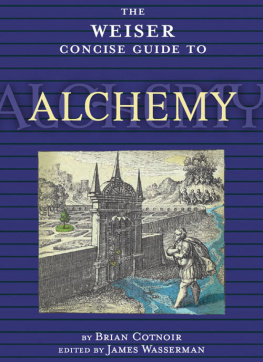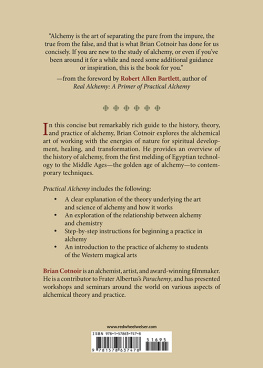
First published in 2006 by
RED WHEEL/WEISER, LLC
With offices at:
500 Third Street, Suite 230
San Francisco, CA 94107
www.redwheelweiser.com
Copyright 2006 Brian Cotnoir
Introduction 2006 James Wasserman
All rights reserved.
No part of this publication may be reproduced or transmitted in any form or by any means, electronic or mechanical, including photocopying, recording, or by any information storage and retrieval system, without permission in writing from Red WHEEL/WEISER, LLC.
Reviewers may quote brief passages.
Library of Congress Cataloging-in-Publication Data
ISBN: 978-1-57863-379-1
Text design by STUDIO 31
www.studio31.com
Typeset in Sabon Roman
10 9 8 7 6 5 4 3 2
Printed in Canada
TCP
If the fool would persist in his folly, he would become wise.
PROVERBS OF HELL
William Blake
This book is dedicated:
To RC, who taught me to read and that
curiosity may have killed the cat but,
satisfaction brought him back.
To FC, who taught me that there is nothing supernatural,
only natural laws we don't understand.
To EW, for grammar, grace, and beauty.
To the dakinis ML, LC, SC, SF, MM, and ST, who gave
with eyes, heart, and handslight, love, and protection.
Sororis mysticae meae, m j mlok LV.
j mlok LV.
To my teachers too numerous to mention.
To all those who have gone before.
and
To the one who comes after.
It is my hope that only good may come of this.
Acknowledgments
I would like to thank:
JAMES WASSERMAN
for the opportunity to present this
report from the front and for his patience and faith in me;
SANDRA FEIST, INA L. CHOW, and MARIA LEVITSKY,
for their corrections and suggestions;
LUCILLE CARRA, ELLEN WOOD, and LENKA VA EKOVA
EKOVA
for their general feedback and encouragement;
SESTHASAK BOONCHAI and SUSAN McCANN
for the book's illustrations;
and finally Tover for lending me his mom.
Disclaimer
The practice of alchemy involves working with chemical supplies and techniques that may be dangerous or fatal if done improperly. Every effort has been made in the text to encourage the practitioner both to use proper safety precautions in the experiments suggested and to equip him- or herself with additional formal training in laboratory procedures. In the case of herbal preparations, consult with a physician before ingesting any herbs or tinctures discussed herein. The author, editor, and publisher disclaim any and all responsibility for accidents or problems resulting from improper use of this material. This book is intended for informational purposes only.
CONTENTS
INTRODUCTION
by
James Wasserman
I T IS A DISTINCT PLEASURE to introduce this brilliant book on alchemy by my friend Brian Cotnoir. Well over thirty years ago, Brian walked into Samuel Weiser's Bookstore in New York City where I then worked. I was twenty-four, Brian seventeen. His utter seriousness of purpose struck me then and remains my assessment of him to this day.
Brian describes this book as the one he wishes had been available when he began his lifelong study of alchemy. I challenge any reader to find a more succinct and clear guide to this science and art. Brian begins with the Work. Totally eschewing what I have long considered to be the superficial psychological interpretation of modern deconstructionists driven to trivialize anything beyond their own limited view of reality, this book begins by defining exactly what alchemy is, and how it can best be approached by one who seeks to learn it secrets. Laboratory techniques and equipment are then discussed in an earnest and serious manner that only highlights the intensity of the historical overview he next provides.
The reader becomes immediately aware that we are tracing the footsteps of historical heroes who risked life and limb to plumb the secret depths of Sacred Nature. And who did so while enflamed in prayer. Thereby did these giants give rise to modern chemistry and physics. Yet something was lost in the process. The failing of the eighteenth-century Enlightenment movement was its embrace of hyperrationalism. The empirical imperative turned True Science on its head. The scientist/adept was forced to deny the sense of humility and wonder that his research engendered. The love for the Creator who fashioned the miracle of matter was relegated to the superstitions of the past.
The author proceeds to a thorough overview of the theoretical universe of the practicing alchemist. Why should a process performed on matter redound to the spiritual benefit of the operator? And how does an action performed on one thing transform it into another thing entirely? Can someone really turn lead into gold? As Brian writes:
By finishing what nature had started by separating, purifying, and balancing the three principles and recombining them, lead could be completed and perfected, transmuted into gold.
With little delay, Brian plunges the reader into the actual alchemical work itself. Beginning with the Herbal Work, you will be working with formulas and heat sources, chemicals and labware. Instead of the instantaneous gratification our culture expects from television and email, you will be directed to undertake works of the alchemical art whose stages are measured in months. You will be ever reminded that prayer and mantra, meditation and spiritual integrity, along with grace, will be the necessary concomitants of your work.
By the time you have come through the Herbal Work, you will have developed the techniques and skills to begin the next level. For this book now takes the reader directly into the more complex and dangerous Mineral Work. The author suggests you consider attending a class in laboratory techniques at a local college if you wish to gain the most benefit from his writings. You will now be entering that sacred space in which one's magical implements become the beaker and burner, the flask and scales.
Will you personally manage to transform lead into gold? If such a thing is possible (and I believe it is) and if you are willing to invest the effort required to succeed in such work, I can think of no better book to send you on your way. And if you have already read other books on alchemy and been mystified, confused, or disappointed, get ready for a transformative experience. For here you will encounter a masterful guide to the Path of the Wise. And its excellent bibliography will provide valuable direction for your continued journey.
PREFACE
T HE PURPOSE OF THIS BOOK is to provide an entryway into the world of alchemy, its fundamental principles and practices. It is the sort of guide I wish I had had when I started my investigations many years ago. It is my hope that this small endeavor will be helpful to those who wish to further explore alchemy.
The work will provide some basic, but essential, theory. It presents a framework that should be developed (or discarded) as your own work on the alchemical path develops. To actually practice alchemy, the techniques encountered in cooking, brewing, and building fires are all that are really necessary at first, and much of alchemy can be done using only these techniques. Some of the more advanced work requires knowledge and experience with high temperatures and some very toxic and caustic materials, and to this end I would highly recommend a few practical chemistry classes and perhaps some metalworking classes in order to learn safe techniques and handling of materials. However, to begin, much of the basic work and the preparation for more advanced alchemical work can be done with the aforementioned skills.
Next page









 j mlok LV.
j mlok LV. EKOVA
EKOVA